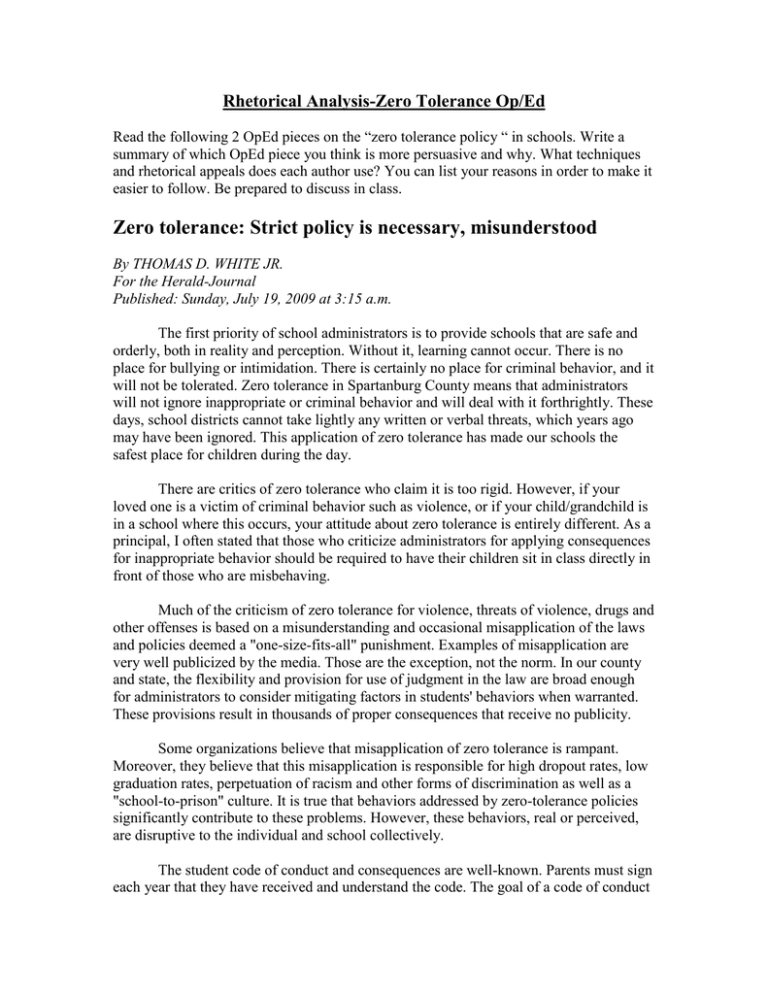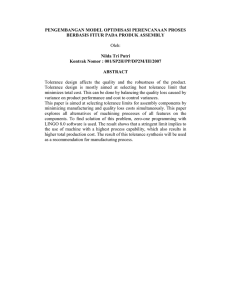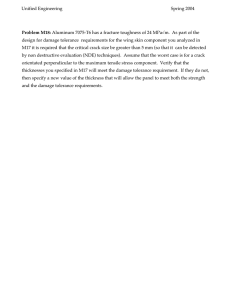Zero Tolerance OpEd .doc
advertisement

Rhetorical Analysis-Zero Tolerance Op/Ed Read the following 2 OpEd pieces on the “zero tolerance policy “ in schools. Write a summary of which OpEd piece you think is more persuasive and why. What techniques and rhetorical appeals does each author use? You can list your reasons in order to make it easier to follow. Be prepared to discuss in class. Zero tolerance: Strict policy is necessary, misunderstood By THOMAS D. WHITE JR. For the Herald-Journal Published: Sunday, July 19, 2009 at 3:15 a.m. The first priority of school administrators is to provide schools that are safe and orderly, both in reality and perception. Without it, learning cannot occur. There is no place for bullying or intimidation. There is certainly no place for criminal behavior, and it will not be tolerated. Zero tolerance in Spartanburg County means that administrators will not ignore inappropriate or criminal behavior and will deal with it forthrightly. These days, school districts cannot take lightly any written or verbal threats, which years ago may have been ignored. This application of zero tolerance has made our schools the safest place for children during the day. There are critics of zero tolerance who claim it is too rigid. However, if your loved one is a victim of criminal behavior such as violence, or if your child/grandchild is in a school where this occurs, your attitude about zero tolerance is entirely different. As a principal, I often stated that those who criticize administrators for applying consequences for inappropriate behavior should be required to have their children sit in class directly in front of those who are misbehaving. Much of the criticism of zero tolerance for violence, threats of violence, drugs and other offenses is based on a misunderstanding and occasional misapplication of the laws and policies deemed a "one-size-fits-all" punishment. Examples of misapplication are very well publicized by the media. Those are the exception, not the norm. In our county and state, the flexibility and provision for use of judgment in the law are broad enough for administrators to consider mitigating factors in students' behaviors when warranted. These provisions result in thousands of proper consequences that receive no publicity. Some organizations believe that misapplication of zero tolerance is rampant. Moreover, they believe that this misapplication is responsible for high dropout rates, low graduation rates, perpetuation of racism and other forms of discrimination as well as a "school-to-prison" culture. It is true that behaviors addressed by zero-tolerance policies significantly contribute to these problems. However, these behaviors, real or perceived, are disruptive to the individual and school collectively. The student code of conduct and consequences are well-known. Parents must sign each year that they have received and understand the code. The goal of a code of conduct is to assist students in accepting responsibility for their actions and guide them toward success-making behaviors. Local school boards and school systems in general go to great lengths to assist students who have behavioral and learning challenges. No one wins if a student does not stay in school and graduate. For the vast majority of students, removal from school is temporary. Most are assigned or permitted to utilize alternative educational opportunities while they "earn" their way back into the regular school setting. Critics also point to the use of school resource officers leading to a school "pipeline-to-prison" culture. Not so. South Carolina law requires administrators to contact law enforcement authorities when criminal conduct occurs. The checks and balances of due process, especially for students with disabilities, ensure that only truly criminal behavior is handled by law enforcement, without discrimination. The rights of students who misbehave are quite detailed, and due process is followed rigorously regardless of the background or characteristics of the student. We should be just as concerned about the rights of countless other students who are behaving appropriately. Finally, most organizations support prevention, early intervention and rehabilitation efforts. Like many across South Carolina, programs to assist parents and children in Spartanburg County school districts include the following: u Therapeutic Behavioral Services for 3-year-old children. u Pre-school services for 4-year-olds. Through Child Find and for those who register, 4-year-olds are screened, and those with the greatest need are served with available resources. Also, districts collaborate with Piedmont Community Action's Head Start, a federally funded program serving economically disadvantaged pre-school children. u Countdown to Kindergarten. In the summer, teachers visit the homes of many children going into kindergarten. u Family Connections. This program provides day care and parenting education for adults attending GED or other adult education programs. u Tutoring programs. Offered in most elementary and middle/junior high schools both before school and after school, these are partnerships with Spartanburg County Parks and Recreation, Boys & Girls Clubs, 21st Century Grant programs or in-house programs such as Warrior Academy and Beyond the Bell. u Recovery and advancement programs for middle school and high school students. Programs such as Advancement Via Individual Determination (AVID), Viking Academy, Fresh Start, Gateway to College, Linking Institute for Navigating Knowledge (LINK), Scholars Academy, credit recovery and more assist students to recover from poor decisions and to advance their education. u Psychosocial rehabilitative services. Districts provide these services as well as access to mental health counselors and social workers, to students ages 6-21. u Alternative programs. For students whose behaviors warrant removal from the regular school setting, districts offer these programs both during and after the normal school day. Spartanburg County Alternative School and the Temporary Intervention Program (TIP) are examples. u Character education programs in all schools. u Mentoring services. All schools have partnerships with community and faithbased organizations to provide mentoring. Citizen Scholars is an excellent example. I urge you to have zero tolerance for complacency. Mobilize your faith-based, civic and/or other organizations to help keep schools safe and to address the needs of our most challenging students. Thomas D. White Jr. is superintendent of School District 7 and immediate past president of the superintendents' division of the S.C. Association of School Administrators. Zero tolerance: School-to-prison pipeline must end By VICTORIA MIDDLETON For the Herald-Journal At the close of the school year, most educators and parents were busy celebrating school promotion, graduation, academic awards and other milestones in their children's lives. A significant minority, however, had no cause to celebrate. Their children are traveling a darker pathway: the so-called "school-to-prison pipeline." This is a phenomenon only too familiar to school discipline officials, public defenders and civil liberties advocates alarmed by the rate of juvenile incarceration in our nation. The pipeline describes the spiraling growth in zero-tolerance discipline, schoolbased arrests, disciplinary alternative schools and secure detention that have swollen our juvenile justice facilities and denied our most at-risk youths access to education. Even the American Bar Association has criticized zero-tolerance policies as too harsh, arguing that they have "redefined students as criminals, with unfortunate consequences." In 2008, the S.C. Department of Juvenile Justice reported that the No. 1 cause of admission to the DJJ was "disturbing schools," a vague and broad concept. Around our state, news reports reveal that it is used to characterize offenses including food fights, slamming lockers and acting "obnoxiously." According to the DJJ, such referrals had increased by 60 percent in the previous 10 years. This trend is reflected nationally. Across the United States, an increasing number of schools rely on police officers to patrol school hallways. Children are more likely to be arrested or interrogated at school — often for nonviolent offenses such as disruptive conduct — and to be expelled for truancy. These more minor cases of misbehavior swell the judicial system and divert resources from serious offenses. Children with special needs are disproportionately represented in the school-toprison pipeline despite having special protections under the law. Special needs students have been detained without access to medications or contact with their families for minor offenses. Surely the place for many of these students, rather than behind bars, is with parents and counselors, literacy teachers and specialists who can offer positive behavioral support. A severely punitive response to often trivial and nonviolent behavioral problems has not increased the safety of our schools, but it has drastically increased the cost to taxpayers of dealing with troubled youths. A conservative estimate puts the cost of locking up a child at double that of educating him or her. According to a report published by the Alliance for Excellent Education, if all of South Carolina's high school dropouts in 2007 had graduated with their class, their contribution to the economy of our state would be roughly $8 billion over their lifetime. The productivity cost of incarcerating rather than educating these children is enormous. Granted, the Department of Juvenile Justice's 2008 "Report Card," or agency performance appraisal, notes some progress in recent years: More school districts are committed to managing behavior problems and truancy without involving police, and to keeping more students out of the juvenile justice system. To improve school discipline, we should create positive and supportive learning environments for students and teachers, and invest in classroom management training, conflict resolution, guidance counseling and mediation training. In addition, it is vital that we diagnose and treat learning disabilities and mental illness at the earliest possible stage of a child's development. Waiting until students wind up in juvenile detention to diagnose and treat learning disabilities is both unfair to our children and costly to our community as a whole. Though these kinds of measures are threatened by the current budget crisis, they in fact have been proven to reduce costs and increase public safety by keeping children in school. The costly alternative will be increased incarceration and unemployment. The economic crisis offers an opportunity to invest in our children's future. It's an opportunity we can't afford to waste. Victoria Middleton is executive director of the ACLU SC national office in Charleston.


